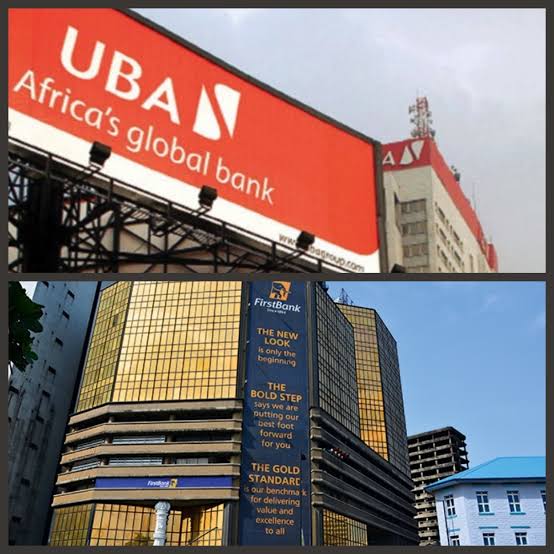by NIyi JACOBS
Investors in Nigeria’s financial markets are becoming increasingly cautious as the country’s biggest banks confront a combination of recapitalization pressure, foreign exchange volatility, and rising credit risks.
Despite glowing profit figures, United Bank for Africa (UBA) and FirstHoldco—the holding company that owns FirstBank of Nigeria—are facing renewed scrutiny from investors and analysts who fear that the strong earnings being reported across the banking sector may not translate into sustainable value in the long term.
Both institutions are among the country’s most systemically important banks, and their performances are often used as a gauge of overall sector health. But beneath the impressive earnings numbers lies a more complex reality of eroding margins, growing non-performing loans (NPLs), and a market that is becoming increasingly disillusioned with short-term gains unsupported by structural strength.
UBA and FirstHoldco—two members of the elite FUGAZ group—have delivered impressive top-line numbers in recent years. UBA’s shares have gained 26.3% year-to-date (YtD), trading at ₦42.95 as of October 20, 2025, which represents about 85% of its 52-week high. FirstHoldco’s shares have also climbed 15.9% YtD to close at ₦32.50.
At first glance, these figures seem encouraging. However, both banks have underperformed the broader market, which has advanced by 45.68% YtD. In 2024, UBA returned 33% while FirstHoldco posted a modest 19%, highlighting a persistent struggle to keep up with market optimism.
The problem, analysts say, lies not in profitability but in investor confidence. The Nigerian market has become more sensitive to risk exposure, funding costs, and potential dilution from the ongoing recapitalization exercise ordered by the Central Bank of Nigeria (CBN). As a result, even top-tier performers are being reassessed for their ability to maintain earnings growth under new capital requirements.
Both UBA and FirstHoldco are racing to meet the new capital thresholds for international banks—₦500 billion in paid-up capital. While both are well-positioned compared to smaller banks, the scale of the recapitalization still poses a significant threat to shareholder value.
UBA’s steady momentum could be blunted if it decides to issue additional shares to raise capital, potentially diluting earnings per share (EPS). For FirstHoldco, the concern is even more pronounced. With a relatively weaker capital buffer and a high NPL ratio, the group may need a more aggressive capital raise to meet regulatory targets.
This could force both institutions to choose between profit retention and shareholder payouts, creating tension between regulatory compliance and investor satisfaction. For yield-hungry investors, the prospect of lower dividends and reduced EPS is already casting a shadow over the sector’s near-term attractiveness.
UBA closed the first half of 2025 with a pre-tax profit of ₦388.41 billion—a 3.28% year-on-year decline from the same period in 2024. The dip was largely driven by foreign exchange and trading losses, as well as rising operating expenses, particularly employee benefit costs.
Though interest income surged 33% to ₦1.33 trillion, much of the gain came from Nigeria’s high-yield environment rather than operational efficiency. With the CBN expected to sustain tight monetary policy into 2026 to control inflation, this environment may soon reverse, putting pressure on net interest margins.
FirstHoldco’s story mirrors this pattern. The group reported a pre-tax profit of ₦356.1 billion in H1 2025—a sharper decline of 13.4% year-on-year. Fair value losses of ₦69.7 billion replaced gains of ₦423.9 billion recorded in the same period of 2024, reflecting volatility in both its trading and investment portfolios.
Despite this, the bank’s interest income rose to ₦1.43 trillion from ₦947.7 billion, reflecting increased exposure to riskier lending and investment assets. Analysts warn that such aggressive positioning, while boosting short-term income, could expose the bank to higher default risks as credit conditions tighten.
Over a five-year horizon, UBA accumulated ₦1.78 trillion in profits after tax (PAT), growing at a compound annual growth rate (CAGR) of 46.5%. FirstHoldco, meanwhile, achieved ₦1.35 trillion in PAT at a faster CAGR of 49%.
Yet, this impressive growth masks underlying vulnerabilities. UBA’s steady earnings are increasingly weighed down by FX translation losses from its pan-African operations, especially in markets such as Ghana and Kenya, where currency depreciation has eroded dollar-denominated earnings.
FirstHoldco faces a different challenge: while its holding structure has allowed it to diversify revenue streams, its exposure to domestic credit markets remains high. With NPLs above 10% and a cost of risk near 5%, FirstHoldco’s profitability could deteriorate further if Nigeria’s economic environment worsens.
At face value, UBA appears cheaper. With a price-to-earnings (P/E) ratio of 1.98x, investors pay ₦1.98 for every ₦1 earned. FirstHoldco trades slightly higher at 2.08x, implying a growth premium. But valuation alone can be misleading.
UBA’s earnings multiple is supported by a consistent dividend yield of 7.57% and strong EPS of ₦8.86 in H1 2025. Yet, investors worry about stagnation—with profits plateauing and rising costs offsetting income gains, future growth potential may already be priced in.
FirstHoldco’s higher valuation, on the other hand, reflects optimism rather than performance. The bank’s weaker EPS and thin dividend yield of 1.85% make it vulnerable to any negative sentiment, especially if its recapitalization strategy involves significant share dilution.
Both institutions also face currency risk as Nigeria’s naira remains under pressure. The persistent volatility has led to repeated fair value losses, particularly for banks with significant trading or offshore exposures. Unless the CBN stabilizes the FX market, these losses could continue to eat into profits.
UBA’s reputation for stability is being tested. Its cost of risk rose to 3.18%, and its NPL ratio climbed to 5.6% in 2024. While these levels are manageable, they point to rising strain in loan recovery, particularly in oil and gas and manufacturing portfolios affected by naira weakness and inflation.
FirstHoldco’s situation is more concerning. With an NPL ratio of 10.2% and a cost of risk of 4.7%, the group is significantly more exposed to bad loans than its peers. This could erode profitability if defaults rise in the second half of 2025.
Compounding this problem is Nigeria’s sticky inflation, which continues to drive up personnel and administrative costs. For both institutions, operating expenses are expanding faster than core income, suggesting that efficiency gains from digital transformation are yet to yield meaningful cost savings.
On paper, UBA looks like the superior investment. Its total shareholder return (TSR)—combining capital gains and dividends—stands at 33.89% for 2025, compared to FirstHoldco’s 17.71%.
However, this narrative ignores the broader market underperformance. The NGX All-Share Index has gained nearly 46% YtD, meaning both banks have actually lagged behind the broader market. Investors who diversified into other sectors, such as consumer goods or oil and gas, earned better returns with lower risk exposure.
This underperformance reflects a deeper problem: the market is not convinced that the current profit boom in banking is sustainable. As monetary policy tightens and recapitalization looms, earnings growth may flatten, leading to weaker price momentum in 2026.
The Nigerian banking sector’s profitability in 2024 and 2025 has been largely driven by revaluation gains, FX adjustments, and interest rate hikes—not by genuine expansion in credit or financial intermediation. This makes the current earnings cycle artificially inflated and highly sensitive to macroeconomic reversals.
If rates are lowered to stimulate lending or if the naira appreciates, banks could see their interest and FX income sharply reduced. The anticipated slowdown in government borrowing could also shrink the lucrative market for treasury bills and bonds that currently boost net interest income.
For UBA and FirstHoldco, this presents a dual challenge: sustaining profit growth without relying on high yields, and protecting capital in an environment of rising regulatory costs.
The ongoing recapitalization has become a litmus test for management efficiency. UBA’s relatively stronger balance sheet suggests it may navigate the process smoothly, possibly through a combination of retained earnings and strategic equity raising.
For FirstHoldco, however, the path is less clear. With multiple subsidiaries and a more complex ownership structure, coordinating a seamless recapitalization across its entities could prove difficult. Any delay or investor resistance could undermine confidence, depress share prices, and trigger capital flight to rival banks.
Moreover, both institutions are competing for the same pool of domestic and foreign investors. With other Tier-1 banks like Access Holdings and Zenith Bank offering similar or even better returns, investor loyalty is becoming harder to maintain.
While the Nigerian banking index remains one of the most actively traded on the NGX, sentiment has shifted from optimistic accumulation to cautious observation. Institutional investors are now focusing on balance sheet resilience rather than headline profits.
UBA’s pan-African presence, once considered a strength, is increasingly seen as a liability given the FX risk exposure across its operations in Ghana, Côte d’Ivoire, and Kenya. For FirstHoldco, the challenge is its high reliance on domestic credit and government securities, which limit its flexibility in a downturn.
As a result, both banks’ valuations may continue to stagnate despite strong earnings, as the market prices in long-term structural risks rather than short-term gains.
From all indicators, UBA offers better near-term stability. It is cheaper on a P/E basis, delivers higher dividends, and maintains lower credit risk. Yet, its growth potential appears capped by operating inefficiencies, FX losses, and likely share dilution.
FirstHoldco may have stronger long-term potential, but only if it successfully manages its recapitalization, reduces credit exposure, and restores investor confidence. Its low yield, high NPL ratio, and weaker EPS make it an increasingly speculative play.
In essence, both banks are victims of the same structural weaknesses that plague Nigeria’s financial system—volatile macroeconomic conditions, high operating costs, and unpredictable regulation.
While both UBA and FirstHoldco remain fundamentally sound, the broader macroeconomic landscape suggests that 2025 may mark the peak of the current profit cycle. As the CBN tightens oversight and global investors demand stronger governance and transparency, Nigerian banks will have to prove that their earnings are built on sustainable fundamentals rather than policy-driven windfalls.
For now, investors looking for short-term stability may prefer UBA, but those seeking long-term growth will need to watch FirstHoldco closely—especially how it handles credit quality and capital restructuring.
In either case, the outlook is far from rosy. Unless both institutions address cost inefficiencies, credit risks, and exposure to currency losses, 2026 could bring a sharp correction in valuations across the banking sector.
UBA and FirstHoldco are not just competing for investors—they are racing against time to preserve value in a sector where earnings no longer guarantee confidence.














